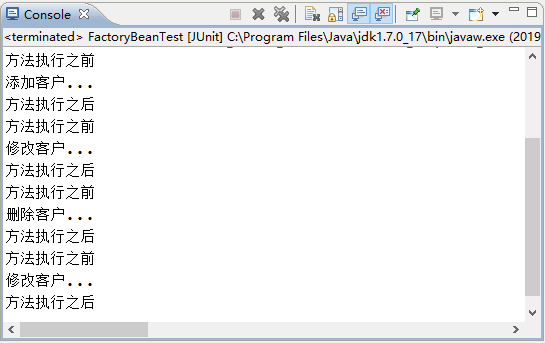您好,登錄后才能下訂單哦!
您好,登錄后才能下訂單哦!
Spring 通知類型
通過前面的學習可以知道,通知(Advice)其實就是對目標切入點進行增強的內容,Spring AOP 為通知(Advice)提供了 org.aopalliance.aop.Advice 接口。
Spring 通知按照在目標類方法的連接點位置,可以分為以下五種類型,如表 1 所示。
表 1 Spring 通知的 5 種類型
| 名稱 | 說明 |
|---|---|
| org.springframework.aop.MethodBeforeAdvice(前置通知) | 在方法之前自動執行的通知稱為前置通知,可以應用于權限管理等功能。 |
| org.springframework.aop.AfterReturningAdvice(后置通知) | 在方法之后自動執行的通知稱為后置通知,可以應用于關閉流、上傳文件、刪除臨時文件等功能。 |
| org.aopalliance.intercept.MethodInterceptor(環繞通知) | 在方法前后自動執行的通知稱為環繞通知,可以應用于日志、事務管理等功能。 |
| org.springframework.aop.ThrowsAdvice(異常通知) | 在方法拋出異常時自動執行的通知稱為異常通知,可以應用于處理異常記錄日志等功能。 |
| org.springframework.aop.IntroductionInterceptor(引介通知) | 在目標類中添加一些新的方法和屬性,可以應用于修改舊版本程序(增強類)。 |
聲明式 Spring AOP
Spring 創建一個 AOP 代理的基本方法是使用 org.springframework.aop.framework.ProxyFactoryBean,這個類對應的切入點和通知提供了完整的控制能力,并可以生成指定的內容。
ProxyFactoryBean 類中的常用可配置屬性如表 2 所示。
表 2 ProxyFactoryBean 的常用屬性
| 屬性名稱 | 描 述 |
|---|---|
| target | 代理的目標對象 |
| proxyInterfaces | 代理要實現的接口,如果有多個接口,則可以使用以下格式賦值: <list> <value ></value> ... </list> |
| proxyTargetClass | 是否對類代理而不是接口,設置為 true 時,使用 CGLIB 代理 |
| interceptorNames | 需要植入目標的 Advice |
| singleton | 返回的代理是否為單例,默認為 true(返回單實例) |
| optimize | 當設置為 true 時,強制使用 CGLIB |
在 Spring 通知中,環繞通知是一個非常典型的應用。下面通過環繞通知的案例演示 Spring 創建 AOP 代理的過程。
1. 導入 JAR 包
在核心 JAR 包的基礎上,再向 springDemo03 項目的 lib 目錄中導入 AOP 的 JAR 包,具體如下。
2. 創建切面類 MyAspect
在 src 目錄下創建一個名為 com.mengma.factorybean 的包,在該包下創建切面類 MyAspect,如下所示。
package com.mengma.factorybean;
import org.aopalliance.intercept.MethodInterceptor;
import org.aopalliance.intercept.MethodInvocation;
//需要實現接口,確定哪個通知,及告訴Spring應該執行哪個方法
public class MyAspect implements MethodInterceptor {
public Object invoke(MethodInvocation mi) throws Throwable {
System.out.println("方法執行之前");
// 執行目標方法
Object obj = mi.proceed();
System.out.println("方法執行之后");
return obj;
}
}
上述代碼中,MyAspect 類實現了 MethodInterceptor 接口,并實現了接口的 invoke() 方法。MethodInterceptor 接口是 Spring AOP 的 JAR 包提供的,而 invoke() 方法用于確定目標方法 mi,并告訴 Spring 要在目標方法前后執行哪些方法,這里為了演示效果在目標方法前后分別向控制臺輸出了相應語句。
3. 創建 Spring 配置文件
在 com.mengma.factorybean 包下創建配置文件 applicationContext.xml,如下所示。
<?xml version="1.0" encoding="UTF-8"?>
<beans xmlns="http://www.springframework.org/schema/beans"
xmlns:xsi="http:/www.w3.org/2001/XMLSchema-instance"
xsi:schemaLocation="http://www.springframework.org/schema/beans
http://www.springframework.org/schema/beans/spring-beans.xsd">
<!--目標類 -->
<bean id="customerDao" class="com.mengma.dao.CustomerDaoImpl" />
<!-- 通知 advice -->
<bean id="myAspect" class="com.mengma.factorybean.MyAspect" />
<!--生成代理對象 -->
<bean id="customerDaoProxy"
class="org.springframework.aop.framework.ProxyFactoryBean">
<!--代理實現的接口 -->
<property name="proxyInterfaces" value="com.mengma.dao.CustomerDao" />
<!--代理的目標對象 -->
<property name="target" ref="customerDao" />
<!--用通知增強目標 -->
<property name="interceptorNames" value="myAspect" />
<!-- 如何生成代理,true:使用cglib; false :使用jdk動態代理 -->
<property name="proxyTargetClass" value="true" />
</bean>
</beans>
上述代碼中,首先配置目標類和通知,然后使用 ProxyFactoryBean 類生成代理對象;第 14 行代碼配置了代理實現的接口;第 16 行代碼配置了代理的目標對象;第 18 行代碼配置了需要植入目標的通知;當第 20 行代碼中的 value 屬性值為 true 時,表示使用 CGLIB 代理,屬性值為 false 時,表示使用 JDK 動態代理。
4. 創建測試類
在 com.mengma.factorybean 包下創建一個名為 FactoryBeanTest 的測試類,編輯后如下所示。
package com.mengma.factorybean;
import org.junit.Test;
import org.springframework.context.ApplicationContext;
import org.springframework.context.support.ClassPathXmlApplicationContext;
import com.mengma.dao.CustomerDao;
public class FactoryBeanTest {
@Test
public void test() {
String xmlPath = "com/mengma/factorybean/applicationContext.xml";
ApplicationContext applicationContext = new ClassPathXmlApplicationContext(
xmlPath);
CustomerDao customerDao = (CustomerDao) applicationContext
.getBean("customerDaoProxy");
customerDao.add();
customerDao.update();
customerDao.delete();
customerDao.find();
}
}
5. 運行項目并查看結果
使用 JUnit 測試運行 test() 方法,運行成功后,控制臺的輸出結果如圖 1 所示。

圖 1 運行結果
以上就是本文的全部內容,希望對大家的學習有所幫助,也希望大家多多支持億速云。
免責聲明:本站發布的內容(圖片、視頻和文字)以原創、轉載和分享為主,文章觀點不代表本網站立場,如果涉及侵權請聯系站長郵箱:is@yisu.com進行舉報,并提供相關證據,一經查實,將立刻刪除涉嫌侵權內容。